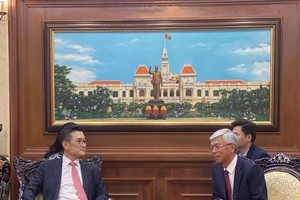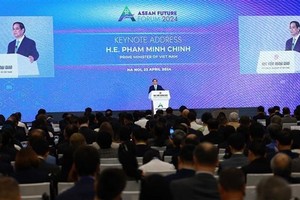The Trans-Pacific Partnership, a trade pact with humble beginnings, is now seen as having the potential to realise a vast free trade zone extending from Chile to China via the United States.
Signed in 2005, the TPP was originally an obscure arrangement between just four members -- Brunei, China, New Zealand and Singapore.
But it got a shot in the arm in 2008 after the United States announced it wanted to join the grouping and invited a few economies to follow suit.
Currently, nine nations are in talks for an expanded TPP -- Australia, Brunei, Chile, Malaysia, New Zealand, Peru, Singapore, the United States and Vietnam.
US President Barack Obama and other Asia Pacific Economic Cooperation (APEC) forum leaders meeting in Honolulu on November 12-13 are expected to agree on a broad framework for the TPP.
But analysts and officials say that further talks are likely, to flesh out the details of a final deal.
The vision for the TPP is for an initial group of economies to form the core of the grouping. Membership will remain open, with more economies added progressively after they agree to the same commitments as existing members.
That would make negotiations more manageable because it will involve a smaller number of economies.
An earlier idea to negotiate a Free Trade Agreement of the Asia Pacific -- which would cover the 21 APEC economies -- failed to take off because of the number of players involved.
The TPP is aimed at achieving just that -- an Asia Pacific-wide free trade zone -- but through a more innovative "take it or leave it" approach designed to lure economies who may feel they can't afford not to join.
Washington, which has taken the lead in the negotiations, has said that the commitments to remove impediments to trade and doing business across the region under the TPP will be deep and extensive to ensure the result will be a quality accord.
The implications for such a trans-Pacific FTA are enormous, especially with the Doha Round of global trade talks still in limbo.
The Pacific Economic Cooperation Council (PECC), a Singapore-based think tank, said the combined economic output of the Asia-Pacific region was $35 trillion in 2010, or a little over half of the world’s total.
"The initiative for TPP has sharpened interest in the wider APEC group, especially with the USA on board," said Simon Tay, chairman of the think tank Singapore Institute of International Affairs.
"Without TPP... APEC would have lost momentum," he told AFP.
Tay said the TPP talks involving nine governments are reported to involve commitments that will go beyond simple tariff cuts. Commitments would even be deeper than existing World Trade Organisation standards, he added.
Japan's Prime Minister Yoshihiko Noda is expected to announce plans to join the TPP negotiations ahead of the APEC summit, according to Japanese media reports.
Other economies like China, South Korea and the Philippines have said they are closely watching the negotiations before taking steps to come on board.
China's foreign ministry spokesman Hong Lei said only that Beijing was "open-minded" about cooperation initiatives like the TPP.
South Korean President Lee Myung-Bak has in the past said his country would consider taking part in TPP.
The Philippines is interested in joining but is waiting to see the criteria and requirements that emerge, according to a senior trade official.
























